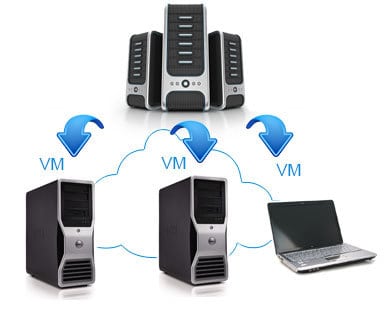Share this
Virtual Desktop Infrastructure (VDI) Makes Sense for Small Businesses
by Nathan.Fouarge on Aug 18, 2014 4:10:32 AM

When people talk about VDI, it seems as though all the talk is centered around how to implement it and the associated costs for large businesses. What does not seem to be getting a lot of attention is how VDI can be implemented in a small business environment, and whether it makes any sense to do it.
What is VDI?
In case you are not familiar with VDI, it’s the old way of logging into mainframes from a terminal, or working with a terminal server. Essentially, you have your hypervisor (ESXi, Hyper-V, Citrix, etc) and virtual machines running that are user desktops that the users log into. Seems simple enough, but why deploy VDI over just keeping physical desktops since there has to be a physical machine for a user anyway?
VDI Makes New Employee Onboarding Faster
There are a lot of reasons to look into whether or not VDI makes sense for you. When I talk about VDI for small business, I am speaking about very small-scale environments such as 20 desktops (or less) to give you an idea of where I am coming from. There are lots of amazing management tools, and better ways to do things in larger environments, but what I am going to talk about is doing it for much less while still realizing the benefits of VDI. The first thing that is amazing about VDI is the ability to have a simple template that you can deploy whenever a new employee comes onboard or when replacing an employee. Yes, you can do a deployment image for physical machines, but you have to setup the hardware, boot from whatever deployment tool you utilize, add it on the machine, boot it, configure it, and run all the updates since last you made the image. And, that assumes the deployment image works on the new hardware without a problem. With a VDI template, you will still have to setup some sort of hardware, whether it be a PC that you configure to just automatically RDP to the VM that you are spinning up, or a true thin/zero client that connects to the VM. With the VDI template, you don’t have to worry about the new hardware issue - and if you start the VDI template up once a month and do the updates on the software, you will not be nearly as far behind as the desktop deployment image.
VDI Makes it Easy to Increase Memory on the Fly
Additional functionality that makes VDI a solid fit in the SMB space is that you can setup high availability for your virtualized servers, while your VDI’s tag along. VDI also allows you to add more resources to a desktop very easily. For example, someone in your sales group might be implementing marketing initiatives and needs to utilize Photoshop or other applications and needs more memory. In the physical desktop world, you would need to source new hardware, install it, and make sure it works. In the VDI environment, you just edit their VDI to have more memory and that’s it. Since all major hypervisors include a type of shared memory, your footprint will not be nearly the amount of physical memory needed if you were doing physical desktops. Memory is just the start, however. Then there is the most often heard catch-phrase in SMB IT: ‘the server is slow.” If that server is on the same virtualization layer as the VDI, you have one less thing to troubleshoot - the hardware layer between the user and the server.
VDI Makes for Easy Management & Restoration
One of the great attributes of VDI is the managability and recoverability that it gives to IT users. If, for example, a user’s desktop’s power supply blows up, or the desktop becomes inoperable, the VDI has all the data! Bring up an old machine that you have in the back from a previous upgrade of a desktop, stock a couple cheap thin/zero clients and you have the user up and running in no time. Recovering a VM backup is so easy, you do not even have to destroy the previous machine like what you would have to do with an image-based backup of a physical machine unless you want to store multiple hard drives. If an employee is leaving, no just simply backup their VDI with our NovaBACKUP and delete the original VM - no messy reformatting of machines or struggling to know what data to keep from the previous users machine. What if a user moves to another branch office? No big deal, if that other branch office has it’s own virtual infrastructure. Then, you can use NovaBACKUP to replicate the VM to the other virtual infrastructure, or if they don’t and they utilize the VDI of the main location, it’s as simple as having them connect to the same VM they are right now.
VDI is Affordable for Small Businesses
Some final words about VDI. With whatever vendor or partner you are working with, make sure they understand what you want to do and do not let them sell you a bill of goods. Whenever the word VDI comes up, it seems like all everyone sees is dollar signs. In a small business environment you do not need a huge VDI implementation, you do not need VMware View or other expensive pieces of software. I have helped setup a VDI type of environment with VMware’s Essential $600 bundle with no problems. Make sure you know what you are getting with both the software and hardware. Would the $5,000 that Partner A put down for virtual backup software be better served by buying NovaBACKUP Business Essentials for a fraction of the cost and putting the remainder in faster storage, or more ram instead of features that you will never use as a small business? The answer is a resounding yes.
Share this
- Pre-Sales Questions (109)
- Tips and Tricks (99)
- Industry News (58)
- Reseller / MSP (39)
- Best Practices (33)
- Security Threats / Ransomware (29)
- Applications (26)
- Disaster Recovery (26)
- Cloud Backup (24)
- Compliance / HIPAA (24)
- Backup Videos (23)
- Storage Technology (23)
- Virtual Environments (17)
- Infographics (8)
- Technology Updates / Releases (8)
- Backup preparation (5)
- Products (US) (3)
- Company (US) (1)
- Events (1)
- Events (US) (1)
- April 2025 (1)
- March 2025 (1)
- February 2025 (2)
- January 2025 (2)
- December 2024 (1)
- November 2024 (1)
- October 2024 (1)
- September 2024 (2)
- August 2024 (1)
- July 2024 (2)
- June 2024 (2)
- May 2024 (1)
- April 2024 (2)
- March 2024 (2)
- February 2024 (2)
- January 2024 (1)
- December 2023 (1)
- November 2023 (1)
- October 2023 (1)
- September 2023 (1)
- August 2023 (1)
- July 2023 (1)
- May 2023 (1)
- March 2023 (3)
- February 2023 (2)
- January 2023 (3)
- December 2022 (1)
- November 2022 (2)
- October 2022 (2)
- September 2022 (2)
- August 2022 (1)
- July 2022 (1)
- June 2022 (1)
- April 2022 (1)
- March 2022 (2)
- February 2022 (1)
- January 2022 (1)
- December 2021 (1)
- November 2021 (1)
- September 2021 (1)
- August 2021 (1)
- July 2021 (1)
- June 2021 (1)
- May 2021 (2)
- April 2021 (1)
- March 2021 (2)
- February 2021 (1)
- January 2021 (1)
- December 2020 (1)
- November 2020 (1)
- October 2020 (2)
- September 2020 (4)
- August 2020 (2)
- July 2020 (1)
- June 2020 (1)
- May 2020 (1)
- April 2020 (1)
- March 2020 (3)
- February 2020 (2)
- January 2020 (2)
- December 2019 (1)
- November 2019 (1)
- October 2019 (1)
- August 2019 (1)
- July 2019 (1)
- June 2019 (1)
- April 2019 (1)
- January 2019 (1)
- December 2018 (1)
- November 2018 (2)
- August 2018 (3)
- July 2018 (4)
- June 2018 (2)
- April 2018 (2)
- March 2018 (2)
- February 2018 (2)
- January 2018 (3)
- December 2017 (1)
- September 2017 (1)
- May 2017 (2)
- April 2017 (5)
- March 2017 (4)
- February 2017 (1)
- January 2017 (1)
- December 2016 (1)
- November 2016 (1)
- October 2016 (2)
- September 2016 (1)
- August 2016 (3)
- July 2016 (2)
- June 2016 (2)
- May 2016 (7)
- April 2016 (8)
- March 2016 (1)
- February 2016 (3)
- January 2016 (12)
- December 2015 (7)
- November 2015 (5)
- October 2015 (6)
- September 2015 (1)
- August 2015 (3)
- July 2015 (2)
- June 2015 (2)
- May 2015 (1)
- April 2015 (4)
- March 2015 (3)
- February 2015 (4)
- January 2015 (2)
- October 2014 (4)
- September 2014 (8)
- August 2014 (5)
- July 2014 (7)
- June 2014 (3)
- May 2014 (3)
- April 2014 (9)
- March 2014 (7)
- February 2014 (7)
- January 2014 (5)
- December 2013 (4)
- October 2013 (7)
- September 2013 (2)


